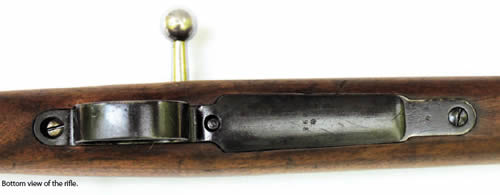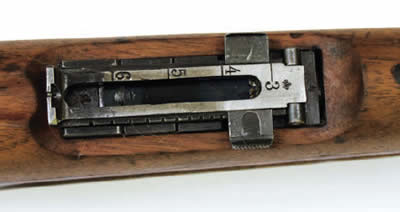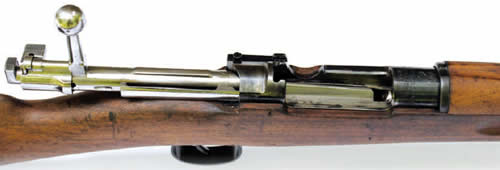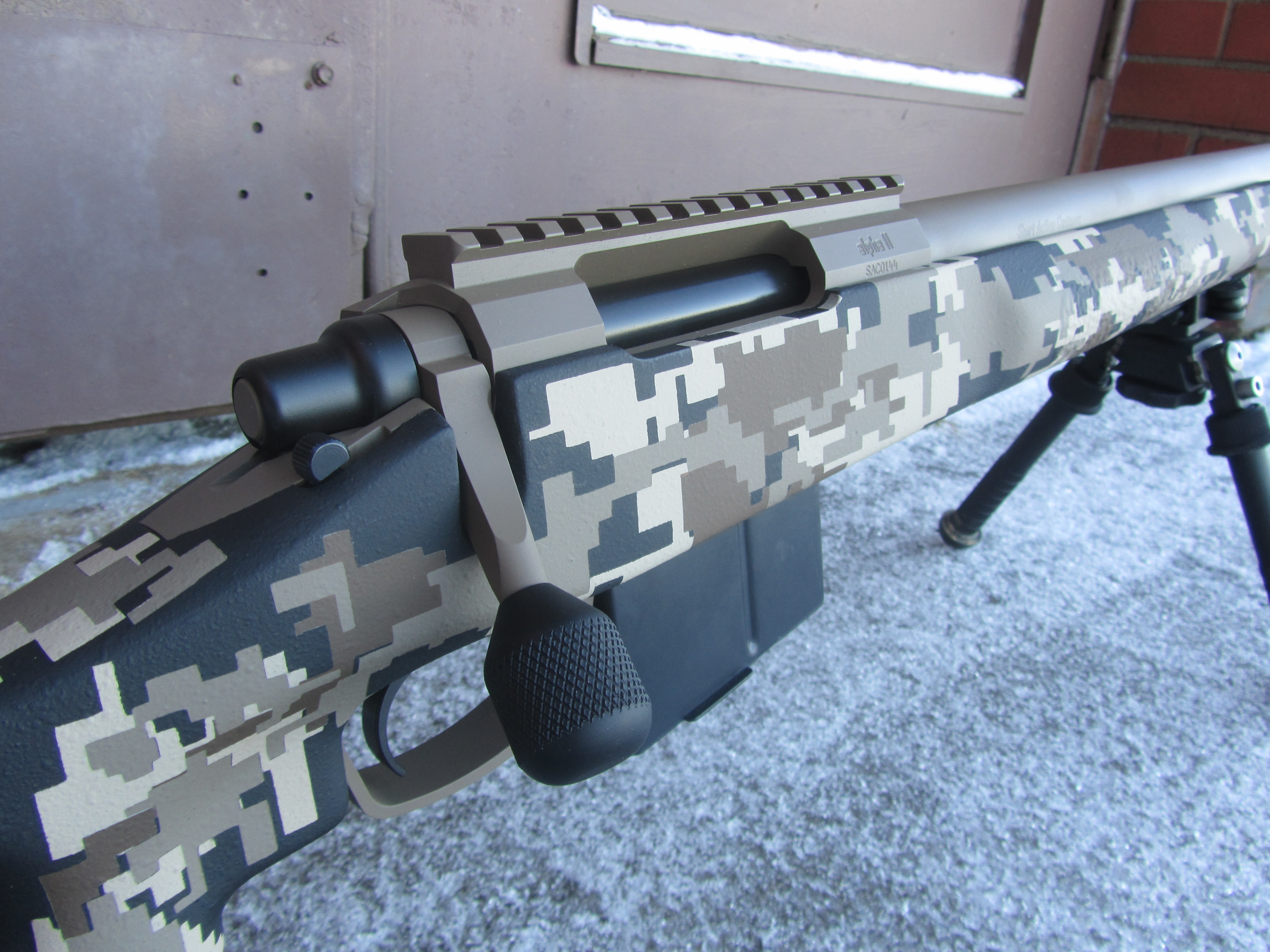A Jewel among Rifles
Why to consider adding a military surplus M96 Swedish Mauser to your Collection.
Always considered a jewel among the many fine Mauser rifles made, the Swedish M96 is a real treasure. This gun has the same action as the M94 carbine that preceded it. I was delighted when Hunter’s Lodge sent me a M1896 Swedish Mauser made by Carl Gustafs for review. These super accurate rifles still see much target competition in Europe today. The M94 and M96 guns feature some significant advances over the M93 and M95 Mausers.
The internal guide rib, which runs along the left locking lug raceway on the M93 series, was replaced with a 2½-inch long guide rib that is part of the bolt body and moves through a slot in the top of the bolt bridge. When the bolt is moved forward and locked, the rib rotates to its spot beneath the rear of the extractor.
The M96 also has two holes on either side of the extractor collar to vent gas from a pierced primer or ruptured cartridge case and a thumb cutout to further direct the gas away from the shooter’s eyes. This thumb cutout is often mistakenly assumed to be there just to facilitate stripper clip loading. It is a vital safety feature and personally I don’t want a modern Mauser action that doesn’t have it. Modern commercial versions of the M98 action typically omit this critical feature, putting their customers at increased risk.
The change recognizable at a glance was the upturn with the grooves on top added to the cocking piece, enabling the striker to be safely lowered or hand-cocked to have another try at a misfire. The cocking piece first appeared on the Norwegian Krag rifle and was carried over to America on first the U.S. Krag rifle and later the M1903 Springfield. The Swedes obviously appreciated the idea of their nextdoor neighbor and incorporated it into their gun. Ammunition quality worldwide did not reach today’s standards until the 1920s, so this feature saw considerable use.
The M96 Swedish Mauser’s safety withdraws the firing pin away from the primer when it is put in the vertical midway position so that a blow to the back of the cocking piece cannot fire a chambered cartridge, yet the safety can now be removed much faster. Centuries of dealing with wolves and bears in the thick Swedish forests had taught the Swedes the importance of getting a weapon in action fast. Really fast.

There is a cleaning rod under the barrel and the bayonet lug has a hole for attaching a monopod for more accurate shooting. The factory and date of manufacture are stamped on the receiver, along with the Swedish coat of arms. The bolt handle sticks straight out on this model. Mauser produced 45,000 Swedish Mausers at their Oberndorf factory and the Swedes produced them under license at the Carl Gustafs and Husqvarna factories. They were still making them in 1943.
IN RECENT YEARS, many were converted to 7.62 NATO by Carl Gustafs and Norma for target shooting. These guns were known as CG63 Competition/Target Rifles and they remain very popular for that today. Those acquired by the Swedish Army were called Gevar 7 and later models were the CG73, CG74 and CG80.
Husqvarna made sporting rifles on the M94 carbine action in 6.5×55, 8mm Mauser, 9.3×57 (286-grain bullet at 2,070 feet per second), and the powerful 9.3×62 Mauser. The 9.3×62 shoots a .365-inch-diameter 286-grain bullet at 2,360 fps. Compare this to the .375 H&H Magnum, which shoots a .375-inch-diameter bullet of 300 grains at 2,500 fps, and you see that the vaunted .375 H&H Magnum is only .01 inch greater diameter, 14 grains heavier, and 140 fps faster than the 9.3×62.
Only a ballistics lab can tell the difference. The game sure can’t. So much for armchair experts who claim any pre-M98 Mauser action rifles are unsafe for 7.62 NATO. Many African professional hunters preferred the 9.3×62 to the .375 H&H because it would work in a standard length action and had consistent bullet performance, unlike the .375 H&H Magnum, which has had many bullet jacket failures even in recent years, no thanks to poor bullets at various times. The 9.3×62 is considered the best caliber possible for Swedish moose hunting and Husqvarna’s M94 action guns in this caliber have always been very popular for moose hunting in Sweden.

Husqvarna also made rifles on the M94 action in caliber .220 Swift, .270, .30-06, and any other caliber requested by the customer. Husqvarna rifles built on the M94 action have a perfect safety record and are highly prized by knowledgeable Swedish hunters today. In more recent years, Husqvarna also made rifles on the 98 Mauser action but these are not under discussion here.
WHEN IT COMES to valuing quality and precision workmanship, no country surpasses Sweden. They expect things to last far longer than other countries do. The actions are made to Best Quality bolt-action standards and over the years British gunmakers built many custom Best Quality rifles on these actions in whatever caliber their customer desired.
The famed Swedish steel came to the forefront in the Swedish-made Mausers. Dolf Goldsmith, famous author of the books on the Maxim, Vickers and Browning machineguns, machinegun authority and Class 3 machinegun dealer, once had three 6.5 but after 15,000 rounds out of each of the three barrels, the Swedish barrels were still good and the accuracy was the same. It still shot the same 4-inch groups that it did in the beginning.
Dolf says these barrels never seem to wear out. Having known Dolf and his love of shooting for years, I can tell you that if anyone can wear out a gun barrel quick, it is Dolf. Swedish steel is carefully refined from some of the purest ore on Earth. The lack of the usual amount of microscopic slag inclusions, where microscopic cracks start in steel, seems to be the reason for this long life. The same quality steel and the high standards of workmanship have kept these guns going strong into the 21st century. The careful Swedish maintenance is well apparent in most examples.

Swedish Mauser barrels converted by a machinist to Vickers machinegun barrels in caliber 6.5 Dutch, as he had bought a large quantity of that ammo cheap. This was Germanmade steel-cased ammo made for the Dutch Schwartzlose machinegun and marked “FUR MG.” It was superbly accurate and Dolf was getting 4-inch groups at 100 yards fired full auto from the Vickers machinegun. Even in a watercooled gun, the maximum life of a machinegun barrel is 15,000 rounds, but after 15,000 rounds out of each of the three barrels, the Swedish barrels were still good and the accuracy was the same.
It still shot the same 4-inch groups that it did in the beginning. Dolf says these barrels never seem to wear out. Having known Dolf and his love of shooting for years, I can tell you that if anyone can wear out a gun barrel quick, it is Dolf. Swedish steel is carefully refined from some of the purest ore on Earth. The lack of the usual amount of microscopic slag inclusions, where microscopic cracks start in steel, seems to be the reason for this long life. The same quality steel and the high standards of workmanship have kept these guns going strong into the 21st century. The careful Swedish maintenance is well apparent in most examples.
THE SPECIFICATIONS OF the M1896 Swedish Mauser Rifle are as follows:

I had 220 rounds to fire through the Swedish beauty, consisting of:
I set out a target at 100 yards and began firing. Trigger pull was flawless and the gun hung steady and was easy to hit with. These long-barreled military rifles are exceptionally steady. It was quick handling and fast on target. Not many guns really are to this degree. Firing it was pure pleasure. I just wished I had more ammunition. It is important to leave these rifles in their military configuration. It would not have held as steady or been as easy to hit with if it had been butchered by so-called “sporterizing,” and the addition of a narrow, unyielding rubber recoil pad on a “sporter stock” would have changed a gun without felt recoil into one with a kick.
The finger groove on each side of the stock was a big help. Those turn-of-the-century rifle designers really knew what they were doing. It’s a pity these grooves went out of style because they really are a help to accurate shooting.
THE GOOD LORD was with me that day and I managed to get the first two shots fired offhand with Prvi Partizan ammo into 1 inch at 100 yards. I stopped there because I know from experience that the heavy, long barrel that hung so steady for the first two shots would start to work against me after that and each succeeding shot would double the previous group size.

Trying to find the right place to hold off on aiming at 100 yards with sights set for a minimum of 300 meters meant that getting the groups in the black was too much to ask. The different trajectory of each different type of ammo tested didn’t help that either. I truly hate sights that don’t start at 100 yards. There are scope mounts available for this rifle that require no drilling, tapping, or permanent alteration of the gun.
That would be the easiest solution to the problem. I was able to get two separate two-shot groups of 1 and 11/8 inches with Norma 6.5×55 Oryx 156-grain ammo. These were also fired offhand at 100 yards.
After this, fatigue set in and I was unable to duplicate these groups. Over the next couple of days, I still could not repeat the results of that miraculous day and had to resort to a bench rest to get 1-inch groups out of the two types of Federal ammunition tested.
Most rifles are not capable of the accuracy of this Swedish M96. I believe it would have shot even tighter groups had I been capable of doing better. This was not even a new rifle with a pristine bore. It had some roughness in the bore and had seen long service since it was made in 1898.
If you want to learn to hit well shooting offhand, you must train the muscles to be steady. I have a semi-auto G3 with a scout scope and it weighs 12 pounds with a loaded 20-shot magazine. Every day I practice holding it on target until I can’t hold it steady anymore. You cannot let up on this daily practice, no matter how big and strong you are. I don’t understand people wanting to do all their shooting off a bench rest.
There has never been a bench rest available anywhere I needed to make a shot. Since I always seem to end up having to shoot offhand and shoot fast, that is the way I practice. The Swedish 6.5×55 cartridge has a superb reputation for accuracy and has always been a proven performer in the hunting field. The Swedes even use this caliber for moose in their country. I regard it as the best of all the 6.5-caliber cartridges, bar none.
AFTER FIRING, THE gun was cleaned with an M1 Garand M10 cleaning rod from Hunters Lodge with an extra section added for the longer barrel length. For those of you who are missing the tip of your cleaning rod, just go to Otis Smart Gun Care and give them the thread size of your cleaning rod.
They can sell you a new brass tip. I put three rods dating back to World War I in service again thanks to them. All thread size. The rifle was cleaned and lubed with an oil used on it in Sweden since the early 1900s, German Ballistol oil. This oil was developed for the German Army in 1904 as the one oil for all of a soldier’s equipment, whether it be steel, wood or leather. It forms an emulsion with water and as long as it is at least 5 percent Ballistol, the water will evaporate off without rusting the metal.
A mixture of 10 percent Ballistol and 90 percent water is used as a bore cleaner for corrosive primers because the salt in corrosive primers is only soluble in water. A mixture of 30 percent Ballistol and 70 percent kerosene makes an arctic gun oil that will work in the coldest arctic conditions. Some of the Swedes will insist that they invented cold, but the Norwegians and the Finns dispute this claim. The wood was dry on this gun so I finished it with Birchwood Casey oil finish. As always, I was well pleased with the results.

The Swedish 6.5 Mauser is a jewel among rifles and because it is a surplus military weapon, the price is very affordable. Otherwise the standard of quality would put the price of this gun out of reach of most people. It certainly makes all the current factory production rifles look cheap by comparison. If you really appreciate quality weapons, you owe it to yourself to get one of these fine rifles.
Story by Jim Dickson



